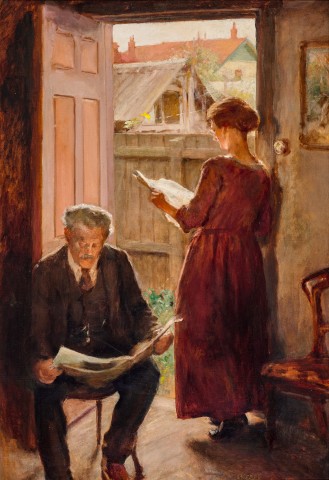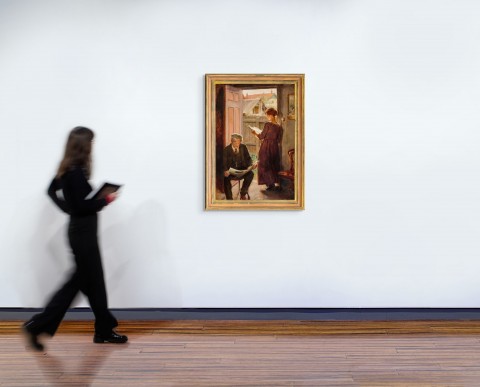THE DOORWAY, 1913
ALICE BALE
oil on canvas
97.0 x 66.5 cm
signed lower right: A M E Bale
The Estate of A.M.E. Bale, Melbourne
Leonard Joel, Melbourne, 5 November 1981, lot 957 (as ’In the Doorway’)
Edward and John Barkes, Sydney and London
Hordern House Rare Books, Sydney
Private collection, Sydney
Bonhams & Goodman, Melbourne, 23 April 2008, lot 18
Private collection, Melbourne
Oil Paintings by Miss Jo Sweatman and Miss A.M.E Bale, Athenaeum Hall, Melbourne, 24 May – 3 June 1922 (as ‘Leisure’)
A.M.E Bale, Rose A. Walker, Athenaeum Gallery, Melbourne, 19 – 30 November 1935, cat. 4
Australian Women Artists, Bridget McDonnell Gallery, Melbourne, 19 September – 8 October 1986
Completing the Picture: Women Artists and the Heidelberg Era, Heide Park and Art Gallery, Melbourne, 3 March – 26 April 1992, cat. 10
Hammond, V., and Peers, J., Completing the Picture: Women Artists and the Heidelberg Era, Artmoves, Melbourne, 1992, pp. 35 (illus.), 36, 80 (as ’Interior (Morning Papers)’)
National Australia Bank, Domestic Life in Australia 1840 – 1920, calendar, 1994 (illus. front cover, as ’Interior (Morning papers)’)
Perry, P., A.M.E. Bale: Her Art and Life, Castlemaine Art Gallery and Historical Museum, Victoria, 2011, pp. 56, 57 (illus., as ’The Doorway (Morning Papers)’)
Leisure moments, 1902, oil on canvas, 148.3 x 118.2 cm, in the collection of the Queensland Art Gallery | Gallery of Modern Art, Brisbane
Suburban Peace, c.1904, oil on canvas on board, 26.5 x 19.5 cm, in the collection of the Castlemaine Art Museum, Victoria
Interior, 1915, oil on canvas, 76.5 x 61.0 cm, private collection
Alice Marian Ellen Bale was born at Richmond, Victoria on 11th November 1875, the only child of William Mountier Bale, Chief Inspector of Customs, and his wife Marian (née Adams). She attended Methodist Ladies College from 1885 to 1892 where she became interested in the arts and, having decided to become a painter, took private lessons from May Vale and Hugh Ramsay. In 1894, she was elected a member of the Victorian Artists’ Society, before enrolling at the National Gallery Art School in 1895 where she won nine major prizes during the course of her studies. During the stormy years of Max Meldrum’s Presidency of the Victorian Artists’ Society (1916 – 17), a group of his supporters formed the Twenty Melbourne Painters Society. Bale was their first secretary and under her leadership the Society flourished for 36 years.
Landscapes, interiors, portraits and still life were Bale’s main interests, and she became particularly renowned for her flower studies. Writing in the catalogue of the 6th Annual Exhibition of the Twenty Melbourne Painters in May 1924, she outlined her objectives in art thus: ‘Truth of tone, of proportion, of colour – that is the aim once the subject is chosen. And in the choosing of the subject such as arrangement of mass and line as shall delight the eye – for pleasure is the essence of Art. The principle of choice, of selection, is inherent in humanity, in the artist above all. It can never be alienated, though it may be unrecognised by its very possessors, and may act so unconsciously as not to feel like another is to be indifferent to all.’1
Illustrated on the cover of the 1994 National Australia Bank calendar entitled Domestic Life in Australia 1840 – 1920, the present scene features a couple engrossed in their newspapers, highlighting the importance of newsprint in the leisure moments of Melburnians’ domestic lives at the time. Notably, the male depicted is Bale’s father who, as a marine biologist and world authority on hydroids, bequeathed many of his specimens and reference books to the National Museum and National Herbarium, Melbourne. Most likely painted in her studio in Kew, The doorway was also included in an early exhibition of paintings by Miss Jo Sweatman and Miss A.M.E Bale held at the Upper Athenaeum Hall, Melbourne from May to June 1922 (under the title ‘Leisure’). And from the same exhibition the National Gallery of Victoria, upon the recommendation of the then-director L. Bernard Hall who held her art in high esteem, notably acquired her Scabiosa, c.1922 – the first work by Bale to enter the collection.
Throughout her life, Bale was staunch in her beliefs and penned numerous letters to newspapers on subjects such as acquisitions for the National Gallery of Victoria; a letter of protest to the Governor General concerning the formation of the Australian Academy of Art; and another to The Argus in 1937 arguing ‘…that there is no gender in art, only good and bad artists.’2 Upon her death on 14 February 1955, Bale’s will directed her trustees to establish an art scholarship bearing her name to encourage painting in representational or traditional art. The scholarship, first awarded in 1969, allowed the holder to live in the estate’s property, the Bale family home in Walpole Street, Kew. In 1981 the trust changed the terms of the scholarship, making it primarily a travelling one to enable Australian painting students to study the works of the old masters abroad.
1. A.M.E. Bale, ‘My Objective in Art’ in 20 Melbourne Painters: 6th Annual Exhibition, Athenaeum Hall, Melbourne, 1924
2. Bale, A.M.E., ‘No Sex in Art’, The Argus, 20 December 1937, p. 10
PETER PERRY


